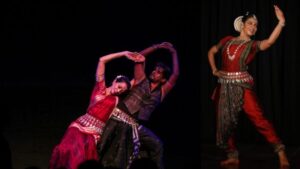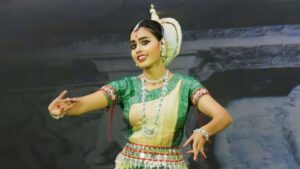Odissi, one of the eight classical dance forms of India, is a mesmerizing art that originated in the state of Odisha. It is a dance tradition that has deep historical roots, steeped in spirituality, mythology, and cultural heritage. Odissi, often referred to as Orissi, is celebrated for its graceful and expressive movements, intricate footwork, and rich storytelling through dance. This introduction delves into the history, evolution, and key elements of Odissi, highlighting its significance in the realm of Indian classical dance.
Historical Origins: The history of Odissi can be traced back to the ancient temples of Odisha, where it was originally performed as a form of devotional dance. Its roots can be found in the Natya Shastra, an ancient Sanskrit text that codified the rules of classical Indian dance and drama. Odissi, like other classical dance forms, has its foundations in the Natya Shastra and has evolved over centuries.
Evolution and Revival: Throughout its long history, Odissi has experienced periods of flourishing creativity as well as suppression. It was closely associated with the temple culture of Odisha, where it was performed by devadasis, female dancers who were dedicated to temple service. However, during the colonial era and later under British rule, the practice of Odissi, like other traditional arts, faced significant challenges.
It was in the 20th century that Odissi experienced a remarkable revival, thanks to the efforts of dedicated individuals and institutions. Dancers like Guru Kelucharan Mohapatra and institutions like the Utkal Sangeet Mahavidyalaya played pivotal roles in preserving and popularizing this art form. Through their dedication and expertise, Odissi once again found its place on the global stage.
Key Elements of Odissi: Odissi is characterized by its unique features and aesthetics, which set it apart from other classical Indian dance forms. Some of the key elements of Odissi include:
- Postures and Mudras: Odissi is known for its distinctive body postures, known as “Bhanga” and “Tribhangi,” which create graceful curves and lines. Mudras, or hand gestures, are used extensively to convey emotions and narratives.
- Abhinaya: The expressive aspect of Odissi is called “abhinaya.” Dancers use facial expressions, eye movements, and hand gestures to communicate stories and emotions to the audience.
- Footwork: Odissi incorporates intricate footwork, with rhythmic patterns created by the feet striking the floor. This aspect, known as “Tala,” adds a dynamic dimension to the dance.
- Music and Instruments: Odissi is accompanied by traditional Odia music, which includes instruments like the mardala (a percussion instrument) and the flute. The music complements the dance and sets the mood for the performance.
- Costumes and Jewelry: Dancers wear elaborate costumes, including the characteristic Odissi saree, adorned with intricate jewelry. These costumes enhance the visual appeal of the dance.
- Themes and Stories: Odissi often draws inspiration from Indian mythology, folklore, and historical narratives. Dancers use their movements and expressions to narrate these stories, captivating the audience with their storytelling prowess.
Benefits
Odissi, one of the most revered classical dance forms of India, offers a plethora of benefits that extend beyond its aesthetic and artistic appeal. This ancient dance form, with its graceful movements, intricate footwork, and rich storytelling, holds numerous physical, mental, and cultural advantages for both performers and enthusiasts. In this essay, we will explore some of the key benefits of practicing and appreciating Odissi.
1. Physical Fitness: Odissi is a demanding art form that requires a high level of physical fitness. Dancers engage in rigorous training that includes stretches, yoga postures, and cardiovascular exercises. The intricate footwork and precise movements help in improving flexibility, strength, and stamina. Regular practice of Odissi can contribute to better posture, enhanced balance, and overall physical well-being.
2. Emotional Expression: One of the most distinctive features of Odissi is its ability to convey a wide range of emotions and stories through dance. Dancers use facial expressions, hand gestures (mudras), and body language to communicate feelings and narratives. This emotional expression not only enhances the artistic quality of the performance but also serves as a therapeutic outlet for the dancers, helping them better understand and manage their own emotions.
3. Cognitive Development: Learning Odissi involves memorizing intricate choreography, rhythms, and sequences. This process enhances cognitive skills such as memory, concentration, and attention to detail. Dancers must also interpret and convey the meaning of the songs and stories they perform, stimulating critical thinking and interpretation abilities.
4. Cultural Preservation: Odissi plays a vital role in preserving and promoting the rich cultural heritage of Odisha and India as a whole. The dance often draws inspiration from Indian mythology, folklore, and historical narratives. By performing and appreciating Odissi, individuals contribute to the preservation and dissemination of these stories, traditions, and cultural values.
5. Stress Reduction: Engaging in the practice of Odissi can have a profound calming effect on the mind. The rhythmic movements, meditative aspects of the dance, and the focus required to execute intricate steps provide an effective means of stress reduction and relaxation. Many practitioners find solace in the dance, using it as a form of meditation.
6. Self-Confidence and Self-Esteem: Mastering the art of Odissi requires dedication, discipline, and hard work. As dancers progress in their training and gain proficiency, they experience a boost in self-confidence and self-esteem. Performing in front of an audience also helps overcome stage fright and enhances self-assurance.
7. Community and Social Integration: Odissi often involves group performances and collaborations with musicians and other artists. This fosters a sense of community and social integration among dancers and enthusiasts. It provides a platform for people from diverse backgrounds to come together, share their passion for the art form, and forge lasting connections.
8. Promotion of Gender Equality: Odissi has a strong tradition of both male and female dancers, breaking stereotypes and promoting gender equality in the arts. Female dancers, known as “Maharis” in the temple tradition, have played a significant role in the history of Odissi, challenging societal norms and paving the way for women in the performing arts.
In conclusion, Odissi is not just a dance form; it is a holistic practice that offers a wide range of physical, emotional, cognitive, and cultural benefits. Its ability to connect individuals with their cultural roots, promote physical well-being, and nurture emotional expression makes it a valuable art form that continues to thrive and inspire people around the world. Whether one is a performer or an enthusiast, Odissi provides a unique and enriching journey of self-discovery and cultural appreciation.




